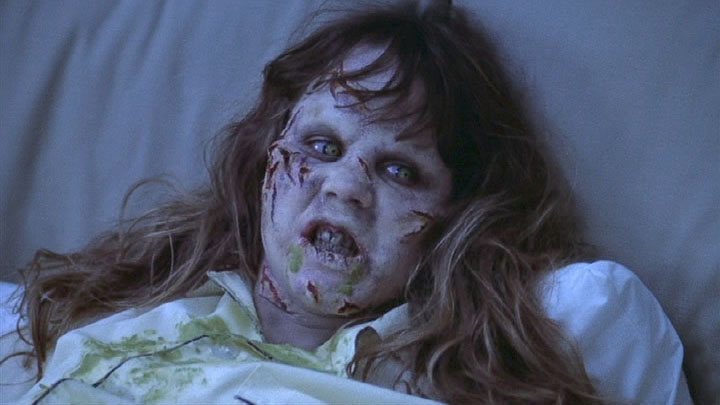Culture
The Bloody Truth: “The Exorcist”

The idea that The Exorcist is a metaphor for a young Linda Blair getting her menses is, well… less than fresh. The theory first came to light amidst the buzz of the film and its shocking scares, but it has been a favorite of feminist film theorists ever since. After all, when all the evidence is compiled, it’s only natural that a hellspawn is created by a female’s recognition of her own sexuality, right? Well, given that the director of the film and the author of its literary source material are both heterosexual males, one can easily understand this as a threat. Furthermore, The Exorcist can easily be interpreted as an extension of the antiquated and patriarchal views of the Catholic Church. However, rather than viewing The Exorcist as a manifestation of Friedkin’s almost Freudian fear of women, it is important to recognize the film as a male-dominated nightmare for women.
Of course, the theory of The Exorcist being about Regan’s (Blair) sexual awakening should be given credence not only as a popular notion, but as a legitimate idea. However, is The Exorcist really Regan’s horror story? It’s true that her body bends and breaks while the demon gleefully toys with his human host, but one could easily argue that Regan is lucid for very little of this. Instead, most of the horror plays out in front of Regan’s mother, Chris (Ellen Burstyn). In order to understand how this terror plays out for the single mother, it is important to recognize a few elements that are crucial to understanding Chris.
First and foremost, she is a single mother. While the film doesn’t spend a great deal of time detailing what went wrong between Chris and Regan’s father, there are a few select scenes where Chris is seen yelling at her ex-husband over the phone. Secondly, she is a working mother. The film introduces Chris on the set of her latest film, being shot in Georgetown. For the rest of the film, Chris is rarely, if ever, seen working. Finally, and arguably least importantly, her name is unquestionably one of the least gender-specific options for the character. All of these characteristics, while they may seem minor, illustrate Chris as a “modern woman”: the product of the second wave feminist movement. She is self-actualized and determined, but throughout the course of this film, these traits are secondary to her role as a mother to a possessed girl.
True, the film begins with Chris at work, but as the film progresses, we see all of the elements of the modern woman disappear before our very eyes. In fact, the only scene even remotely relevant to her career outside of the filming scene is when Chris invites her co-workers over to her home for a party. Here, we see Chris delegate the role of hostess and mother to hired help, who are responsible for preparing food and even sending Regan off to bed. However, as the film progresses, we see Chris begrudgingly accept the role of woman of the house. When her daughter’s fits worsen and she calls upon an exorcist to visit the sick girl, Chris plays the role of doting housewife by getting the priest a cup of tea. While this may seem like an inconsequential event, the movie charts Chris’s fall from independent woman to an uncharacteristically domestic mother.
In this sense, The Exorcist is a well-rounded horror film. While its over-reliance on the viewer’s belief in God or some form of higher power may be off-putting to some, there is some element in the film that is well-rooted in a realistic form of terror. For men, The Exorcist represented the fearful sexual awakening of women. While vomiting and head-spinning are not traditional characteristics of womanhood, the fear that they represent is not so otherworldly. Women were coming into their own, which unquestionably presented a threat to men. Particularly in a male-dominated field such as the entertainment industry, the threat of a female workforce and increased rights for women ran deep. The Exorcist brought those fears to life, albeit in a metaphorical villainess, but the “female threat” was palpable. However, one could easily argue the real victim of the film is Chris, who is stripped of her independence as the film progresses. All of her potential is diminished as her daughter loses herself to the will of a powerful demon. The male author of the book and the male director of the film are exercising what remains of their power to punish the new woman of the 1970s.
The Exorcist serves as a dual-purpose film. For men, it is a reminder of the terrifying power of women and the present they inhabited, one in which women were gaining a voice. For women, it was reminiscent of the domestic past they were still trying to leave behind. The scares of the film aren’t derived from supernatural forces, but from the all-too-real parallels of modern-day living.
[…] previously discussed, The Exorcist would later go on to detail the horrors of womanhood, but Rosemary’s Baby presented […]
[…] heavemedia […]
[…] heavemedia […]